Our meeting scheduler can improve your team’s productivity and focus by improving your meeting etiquette, optimizing schedules across time zones, and streamlining scheduling.
- Manually scheduling and rescheduling is busywork
- A smart calendar assistant streamlines your scheduling, saving time and energy
- Clockwise takes your preferences, Focus Time, and everyone’s time zones into account when suggesting ideal times to meet
No one likes manually scheduled and rescheduling meetings. Well, maybe someone does. But most of us don’t enjoy finding a time, going back-and-forth with everyone you need to meet with, grabbing a room and/or setting up a Zoom, and then having to do it all over again when someone double-books. Add timezones, internal and external attendees, and meeting etiquette to the mix and that’s a lot of busywork.
That’s why efficient teams are using Clockwise to schedule their meetings, optimize their calendars, and resolve conflicts automatically. Here’s how a smart meeting scheduler like Clockwise can help you schedule faster and smarter.
How to schedule meetings with Clockwise
A scheduling assistant is the part of the calendar app that helps you find the best time to meet based on everyone’s availability. Most calendar software offers a scheduling assistant. But standalone tools also integrate with your calendar to simplify scheduling.
One such tool is Clockwise.
One of the worst parts of scheduling new meetings is knowing it will eat into your and your colleagues’ Focus Time. A poorly scheduled meeting in the middle of a block of Focus Time can cost up to 40% of your productive time at work. Teams with more stretches of two or more hours for uninterrupted work get more done faster, bringing in higher revenues, on average.
The Clockwise meeting scheduler suggests meeting times based on their potential productivity impacts. Clockwise automatically generates smart suggestions for when to meet based on more than ten factors, including:
- The timezone of every attendee
- Meeting preferences (e.g., I prefer to meet in the morning)
- Work hours
- Focus Time cost (e.g., will this meeting interrupt a block of free time that could be used for productive work)
- Meeting conflicts
- No meeting day
- Your ratings of meeting moves
- Meeting relief
- Travel time
- How soon you want to meet
- Preserving time for lunch
Clockwise easily handles even the tricky ones for time zones, such as locations that don't respect daylight savings or switch over on different days.
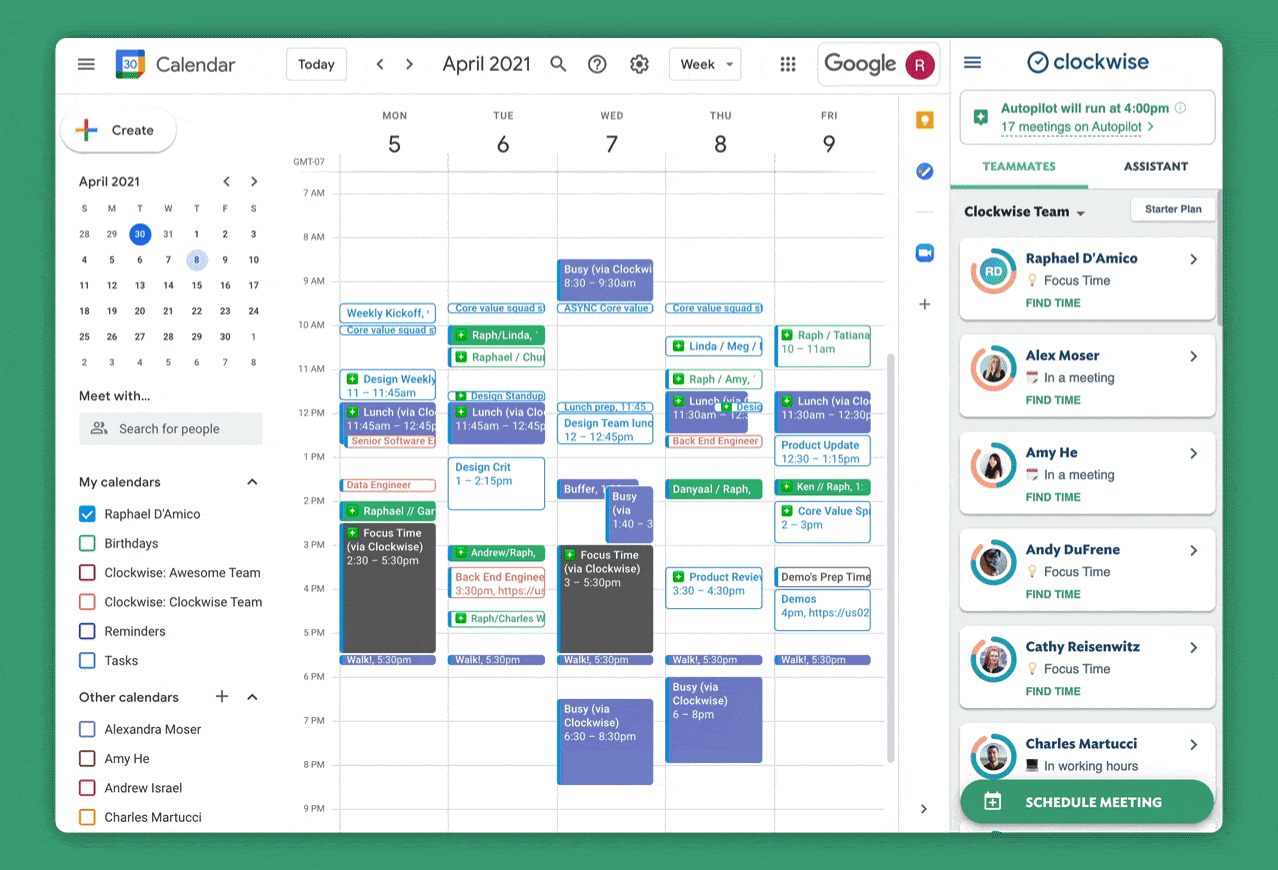
To schedule your next meeting with Clockwise, download Clockwise if you haven’t already.
After onboarding, click the “Schedule Meeting” button from the Clockwise sidebar on your work calendar.
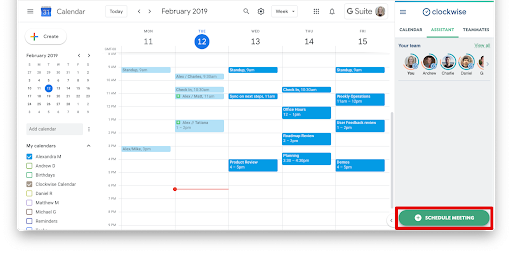
Then, add attendees by typing the email addresses (internal or external) of the people you would like to meet with where it says “Add Attendees.”
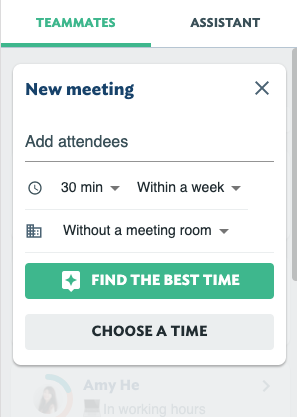
The scheduling assistant will show you the "Best Time" and the "First Available" time to meet. You can see more times under "View more available times."
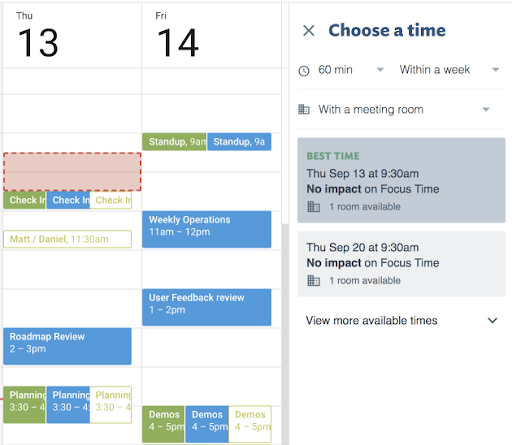
Clockwise will tell you how much Focus Time each meeting will cost at each available time, so you know why certain times are better than others at a glance.
If you choose “Find the Best Time,” Clockwise will automatically select the time that preserves the most Focus Time that meets your duration, time, and date range preferences. Clockwise won’t automatically schedule the meeting. You’ll still need to confirm the selected time.
Note: By default, meetings scheduled with "Find the Best Time" are flexible and might move around within the day to open up more Focus Time.
Whichever time you choose, click on it and add your meeting details. Then to book, just click "Schedule," and Clockwise will book your meeting and send out your invitations.
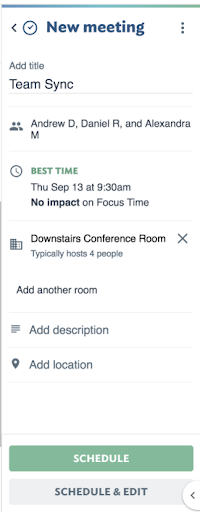
Meeting scheduling etiquette built-in
One of the biggest meeting etiquette mistakes we see people making is not factoring Focus Time into scheduling. Clockwise makes it easy to reduce the negative impact a new meeting has on your whole team’s Focus Time.
Another faux pas: Wasting time going back and forth scheduling and rescheduling. Clockwise also eliminates this busy work for you and your team.
In addition, Clockwise makes it super simple for anyone to create and respect a No Meeting Day for your company or team. After you set up a team in Clockwise, just choose a day:

When someone at your organization tries to schedule a meeting on that day, Clockwise will automatically suggest a different day. Additionally, our flexible meetings feature means Clockwise will automatically suggest the least interruptive time available.
Managing meetings in Clockwise
It’s also easy to view, edit, and reschedule meetings in Clockwise! Once you’re in your Clockwise dashboard, click “Planner” in the left navigation menu. Select the week you want to look at using the arrows in the upper left-hand corner. You should see all of the meetings on your calendar for the week.
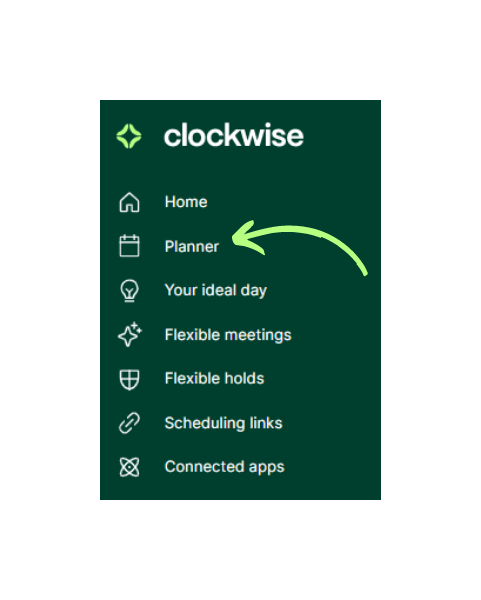
Click into any of your meetings, and an option to reschedule the meeting will appear in the right-hand panel.
Another pain point to scheduling meetings is dealing with calendar conflicts. It’s frustrating to pick a time that works for everyone’s schedule, then have someone come along and schedule right over it!
Clockwise solves this problem (without any effort on your part!) through our flexible meetings setting. When you make a meeting flexible, Clockwise can find the best time based on the abovementioned ten-plus factors. Then if someone schedules over it, no problem. Clockwise will find the next-best time to meet based on all the same information, so you don’t have to follow up manually!
Clockwise also offers another win for team scheduling: You can set flexible working hours in Clockwise to better support your and your team’s scheduling priorities. When you set your working hours in Clockwise, you can split your hours across the day or week.
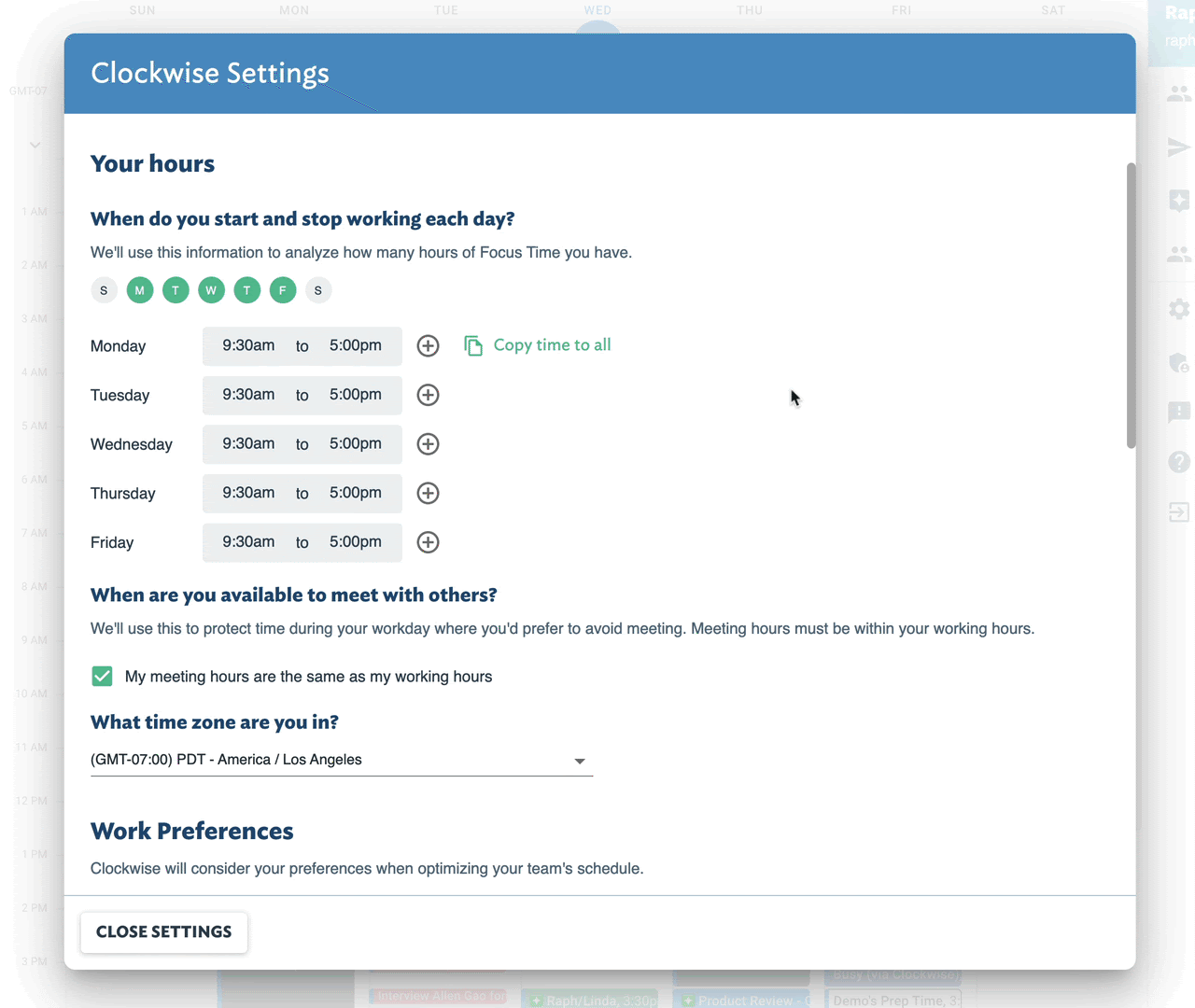
This makes protecting your time for non-negotiables and personal commitments easier, regardless of when you want to work. Add, remove, and update any working hour block as needed. Copying your preferred daily schedule across the week takes just one click. Check out our getting started guide or head to your settings to flex your working hours.
Integrate with other apps for a connected experience
Clockwise syncs with Google Calendar. Not a Gmail user? No problem—join the waitlist for our Microsoft 365 version for Outlook coming soon.
This means Clockwise connects directly with your calendar, so you don’t have to spend time importing meeting details and information. It’s easy to get started with Clockwise as soon as you download it!
We also have integrations with Slack and Asana so that you can connect your workflows for a more seamless experience. With these integrations, you can sync your calendar to your Slack status, turn on Do Not Disturb to mute notifications in Slack, and add tasks as time blocks to your Google Calendar directly from Asana. These integrations can give your productivity the boost it needs to have the best, most efficient workday.
Collaboration via Clockwise
Clockwise takes the responsibility of communicating meeting changes to other attendees off your plate. The tool emails you and your colleagues when flexible meetings change to ensure everyone is aware of recently moved meetings. You can customize your email and notifications preferences to control and customize which emails you want to receive.
Another way Clockwise makes scheduling and collaboration easier for teams is: It shows you and your team when everyone is free. Easily sync your personal calendar so no one schedules over your personal events, either. They show as “busy” with no details for privacy.
Clockwise also integrates team calendars automatically so everyone knows when someone is OOO or on holiday. Plus, you get to each lunch more often as lunch holds appear automatically (based on your settings), so your teammates know when they’re scheduling over your midday break.
Customize meeting types and other advanced features
Clockwise automatically categorizes your meetings for you using machine learning models. Meeting category options include:
- External: A calendar event with an external attendee invited to the event. We will also attempt to recognize external meetings without an external attendee invited.
- One-on-One: A meeting between you and one other internal attendee.
- Team Sync: A recurring meeting between you and multiple other internal teammates.
- Hold: A calendar event with no other attendees that is not an actual meeting (ex: travel time, hold for a meeting)
- Focus Time: Blocks of free time within your working hours longer than 2 hours. Holds for Focus Time should also be included here (e.g., No Meeting Wednesday, WFH)
- Ad-Hoc: Internal, non-recurring meetings
- Out of Office: A calendar event indicating you won’t be in the office (e.g., OOO, PTO, Vacation)
- Holiday: A calendar event indicating this is a holiday and attendees won't be in the office.
- Other events: All other events not captured by the above.
You can also set up color coding for the event types listed above.
Finally, Business and Enterprise plan users can use Clockwise’s meeting and calendar data export. This feature provides 8-week periods of data of Clockwise users and includes the weekly number of focus hours, meetings, and fragmented hours.
Going forward
Scheduling (and rescheduling) manually is busy work that wastes your time and your teammates’ time. Scheduling with a smart calendar assistant like Clockwise streamlines your scheduling, saving you and your team time and energy. Clockwise suggests times to meet that factor in the preferences, Focus Time, and time zones of everyone involved into account. It automatically resolves conflicts, helps you schedule more considerately, and makes it easy to split your working hours.


.gif)



